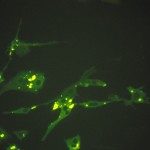Link to Pubmed [PMID] – 12457975
Virus Res. 2002 Dec;90(1-2):207-15
Phylogenetic analysis of three hantaviruses: Hantaan (HTNV), Dobrava (DOBV), and the newly designated serotype/genotype Saaremaa (SAAV) and their respective hosts, rodents of genus Apodemus, reveals a discrepancy in the virus-host relationships. While all Apodemus agrarius sequences from Europe and the Far East are monophyletic, SAAV (carried by the western subspecies of A. agrarius) shared the most recent ancestor with A. flavicollis-associated DOBV virus, but not with HTNV (carried by the eastern subspecies of A. agrarius). This suggests that host switching occurred in the evolution of these hantaviruses. A likely scenario includes transmission of ancestral DOBV to the western form of A. agrarius resulting in the ecological and reproductive isolation of ancestral SAAV. Approximate time-point of the hypothetical host switching estimated from maximum likelihood (ML) phylogenetic tree, 2.7-4.0 millions years ago (MYA), is closer to the present than the expected time of split between the two Apodemus species (not later than 6.5 MYA). Taken together with other proposed cases of host switching, our observations suggest that these events might not be exceptional in the hantavirus evolution.

